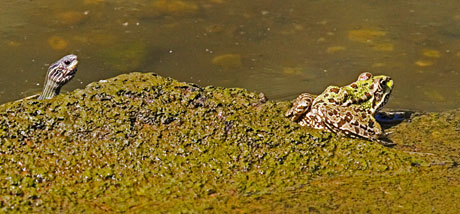 Check |
|
| “Amphibios” from the Greek,
meaning a being with a double life, very appropriate, as a
portion of their life is spent in an aquatic environment and
an even greater portion on land. As there are at least 8
recorded species of amphibians on Corfu, in spring, any
pond, ditch or slow moving river if clean is almost
guaranteed to be populated with a large number of frogs and
newts. The frogs are very fast both on land and in the water
and will disperse in all directions on your approach.
Tadpoles, which are at least double the size or their
northern European counterparts, are present well into
August. Newts can often be found wandering through the
vegetation during the summer and autumn months and are
distinguishable from the lizards by their soft silky skin.
Newts are also much slower in their movements than the
lizards.
|
|
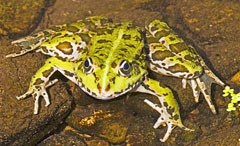 Marsh frog |
Marsh Frog: - (Rana ridibunda). Ridibunda is Europe’s largest frog and is also known as The Lake frog or Laughing frog. There are a number of subspecies of Rana ridibunda to be found around the European continent and eastwards. The name “Ridibunda” translates literally as “laughing”, and when heard in full chorus it is easy to understand why. They rarely venture far from water, sometimes sunbathing at the waters edge only to dive back in when disturbed. Their life cycle is very similar to the common frog although their spawn doesn’t float on the surface, the tadpoles are also substantially larger when hatched.
|
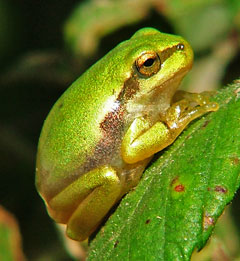 Tree frog |
European Tree Frog: - (Hyla Arborea) Although not regularly seen, can be heard at night when they start their chorus of a gentle “ KRACK--------KRACK” which has been compared to the sound of a duck. They climb through foliage including bushes and trees using their suckered footpads. They have a beautiful bright green colour on the upper surface and a creamy white colour beneath. A distinctive black/brown stripe extends from the side of the face to the hind legs. They can sometimes be found during the day scrunched up on the shaded side of a large leaf for protection from the scorching sun. The tree frog in the Photo is young and perched on a Bramble leaf so you can judge its size! Whereas the adults can reach a size of 60mm or more in length. |
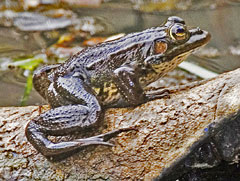 Balkan marsh frog |
Balkan Marsh Frog: - (Rana balcanica). This frog is a very close relation to the Marsh frog (Rana ridibunda). Indeed they are so closely related that hybrids of the two species are thought to exist. The Balkan Marsh Frog has similar habits and is generally found in the same habitat as The Marsh Frog.
|
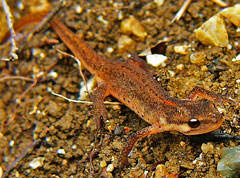 Common newt |
Smooth or common newt: - (Triturus vulgaris). The smooth or common newt is quite common throughout Europe, to be found in many a pond or ditch lacking large fish and with rich vegetation. Contrary to popular belief they spend the majority of the year on land, only to return to water in spring to breed. Newts spend the winter months sheltering beneath a convenient log or rock and whilst on land their diet consists of mainly worms, snails and small insects. In water, aquatic insects are their main source of nutrition. Smooth or common newt. In spring the female will lay up to 300 eggs over a long period, usually a few every day, which she will wrap in the leaf of some water plant. The young, called efts have feather like gills and will grow into their adult form in their first year but will not reproduce until their second or third year.
|
| Also amongst the amphibians are
the Toads, these depending on your point of view can be
fairly large friendly looking creatures. Some of them are
big enough to fill a large soup bowl. The Common toad (Bufo
bufo) has a warty grey/tan coloured skin, sometimes with an
airbrushed rust pigment. The Green toad (Bufo viridis) also has a grey/tan coloured skin but with large irregular green spots and sometimes a rust coloured pigment on its back and the top of its head. They are quite harmless and beneficial creatures in that they rid the garden of many pests? |
|
| Download PDF version of this website with more photographs etc. in the downloads section. | |









